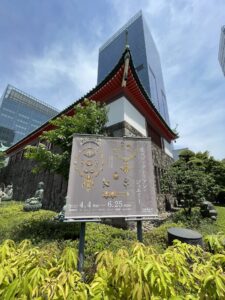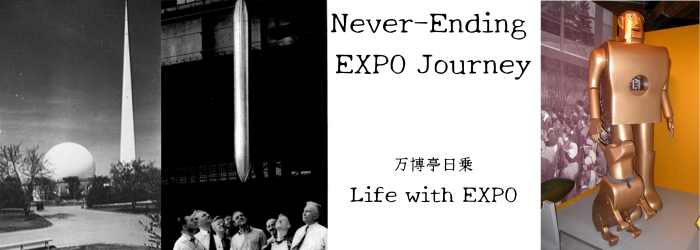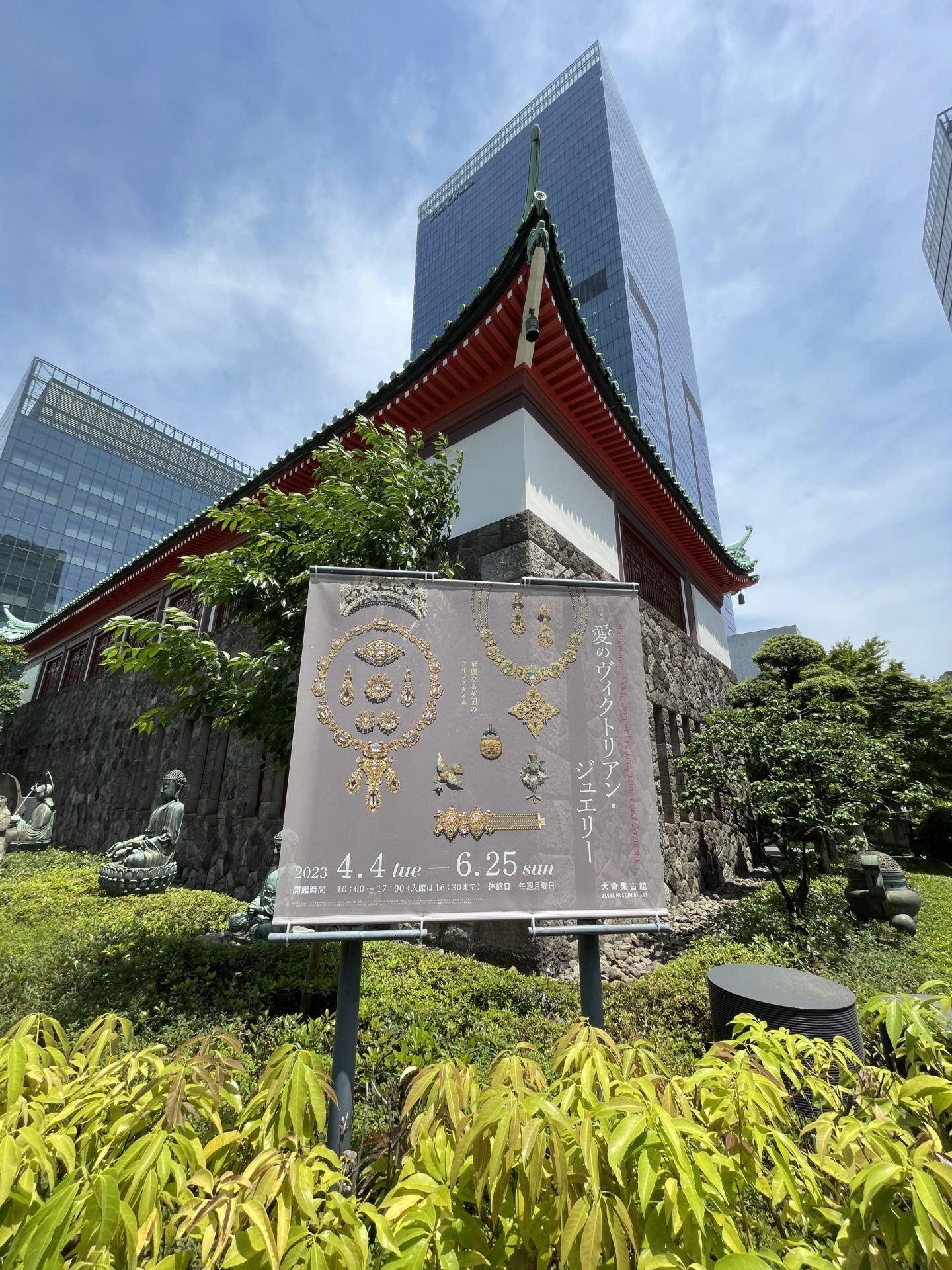“A Celebration of Victorian Jewelry – Love, Leisure and Ceremony” (Okura Museum of Art)
“Okura Shukokan (Okura Museum of Art)” in Tokyo is famous for its collection of Fugen Bosatsu Statue (riding an elephant).
There is a record that the Fugen Bosatsu Statue (riding an elephant) was exhibited at the 1900 Paris World Exposition, and is a National Treasure of Japan.
It used to be on permanent display in this museum, but now it can only be seen occasionally. As an Expo history buff, I feel like I’m more grateful that way.
“Okura Shukokan (Okura Museum of Art)” is currently holding a special exhibition titled;
“A Celebration of Victorian Jewelry – Love, Leisure and Ceremony”.
“A Celebration of Victorian Jewelry – Love, Leisure and Ceremony”
[Date] Tuesday, April 4, 2023 to Sunday, June 25, 10:00-17:00
Since it is an exhibition on England, and moreover in the Victorian era, I have no choice but to check it out. To be honest, I don’t know much about jewelry, but the presence of a Victorian exhibit suggests that there may be some exhibits related to the first historic World Exposition, “the 1851 London Great Exhibition” (“The Great Exhibition of the Works of Industry of all Nations”).
The 1851 London Great Exhibition took place from 1 May to 11 October, 1851 and was strongly promoted and realized by Prince Albert (1819 – 1861), husband of Queen Victoria (1819 – 1901; reigned 1837 – 1901).
If the exhibition this time is from the Victorian era, there must be exhibits related to Queen Victoria and Prince Albert, and if so, we can expect that there may be exhibitions related to the 1851 London Great Exhibition.
According to the website of Okura Shukokan, it says as follows;
*
We will exhibit European antique jewelry that fascinated many people, including not only her royal aristocrats, but also the rising capitalist class during the reign of Queen Victoria, when the British Empire was at its most prosperous.
In addition, we will introduce the gorgeous and elegant world of dresses, lace, silverware, etc. that colored the lifestyle of the British upper class. (translated to English by the author)
*
Looking at the flyer, it seems that various jewelry is on display.
No way, the 186-carat diamond “Koh-i-Noor”, which was exhibited at the 1851 London Great Exhibition and became very popular, should not be on display, but there may be something related to the World Expos.
On the homepage, there is a PDF called “work list”, and I took a look at it.
Many of them are from the early to mid-19th century. This might give you some hope.
Promptly to “Okura Shukokan”
I decided to go there immediately.

大倉集古館
Okura Museum of Art
This Okura Shukokan is located on the grounds of The Okura Tokyo (former Hotel Okura).
The building has a unique design, with Japanese style. The original design was by Chuta Ito (1867 – 1954).
Chuta Ito designed Hitotsubashi University’s Kanematsu Auditorium, Heian Jingu Shrine, and Tsukiji Honganji Temple, etc..
He was also a member of the “Venue Planning Committee” for the 1940 Japan World Exposition, which was called the “Phantom Expo” (determined to be postponed by a cabinet decision on July 15, 1938. It was never held after that due to the World War II).
He is also one of the people involved in the World Expo.
When the Hotel Okura was renovated into The Okura Tokyo, the project of moving the entire building by 6.5 meters was recorded on video, and can still be seen today.


大倉集古館ポスター
Poster, Okura Museum of Art
“A Celebration of Victorian Jewelry – Love, Leisure and Ceremony” Exhibition
Now, let’s move on to the “ A Celebration of Victorian Jewelry ” exhibition.
Starting with a tea set that shines silver, various jewelry is on display. This is quite eye-pleasing. There are many beautiful things.
There are many items related to Queen Victoria, who frequently visited the “Crystal Palace“, a huge greenhouse structure that was the venue for the 1851 London Great Exhibition, which was promoted by her husband, Prince Albert.
According to the captions and the catalog of the exhibition, it says;
“The Ceremony of Exchanging Wedding Rings was also brought to U.K. from Germany by Prince Albert and has since become established in England.”
In addition, “Wedding Cakes decorated with sugar paste on fruit cakes became popular during the royal wedding of Queen Victoria, and have been passed down to the present day.”
So it seems that the ceremony of exchanging wedding rings and the wedding cake began with the marriage of Queen Victoria and Prince Albert.
It is also said that the Wedding Dress worn by Queen Victoria and the Lace Veil she wore at her wedding were also customary to be worn at the wedding.
Furthermore, Afternoon Tea, which is popular also in Japan today, became a form of tea culture in the Victorian era, and developed into an official tea ceremony called “Victorian tea.”
We can see that Queen Victoria and Prince Albert were a couple who not only started the history of World Exposition, but also established various customs in England.
This is a very interesting exhibition.
Double Portrait Bronze Medal of Queen Victoria and Prince Albert
and. . .
What caught my eyes as I was looking at the exhibition, was a rather plain bronze medal.
This medal features overlapping profiles of Queen Victoria and Prince Albert (both to the left).
It is a so-called double portrait.
The profile of Queen Victoria is centered in the center, and the profile of Prince Albert is behind her to the left.
Maybe this is. .
The title of the work says;
“Queen Victoria & Prince Albert Double Portrait Bronze Medal”.
And in the explanation, it says;
“A commemorative medal for the 1st London Great Exhibition, when Britain showed off its wealth and power to the world. It was given to the people who won prizes at the Great Exhibition. The creator was William Wyon, who was famous as a medal maker.
He participated in the Great Exhibition with this medal and was awarded.
The “VICTORIA D.G:BRIT:REG:F.D:” engraved on the surface of the medal indicates that Victoria is the wife of Prince Albert, and “MDCCCLI” means ‘1851’ in Roman numerals. ”
After all, it was a medal from the 1851 London Great Exhibition (!).
However, this commentary does not describe in detail what the medal is.
The Medal System at World Expositions
In the first place, the medal system at Expositions began with the Domestic Expositions that began in France in the early 19th century.
It is widely accepted that the 1851 London Great Exhibition was the first World Exposition, but considerably larger expositions (domestic expositions) have been held in France before.
When the second French National Exposition was held in 1801, Napoleon (1769 – 1821) institutionalized various competitions and associated medals at the exposition.
At that time, 10 gold medals, 20 silver medals and 30 bronze medals were awarded.
Coubertin, learning from the medal system of World Exposition, also introduced the gold, silver, and bronze medal systems of the modern Olympics, which continue to this day.
French National Expositions continued until 1849, two years before the 1851 London Exposition.
Medal system at the 1851 London Great Exhibition
Meanwhile, at the 1851 London Great Exhibition, two types of medals were awarded.
One is “Council Medal” and the other is “Prize Medal“.
The “Council Medal” is the most prestigious award given to only 170 out of 17,000 exhibitors.
Diameter is 89mm.
The design on the obverse is exactly the same as the one on display, a left-facing profile bust of Queen Victoria and Prince Albert. Beneath the bust are two dolphins and to the right is a three-pronged spear representing British naval power. Queen Victoria wears laurel and jewels.
The design and inscriptions on the reverse proclaim the strength of the British Empire in ‘Commerce’ and ‘Industry’.
Three figures are depicted, the woman depicted high in the middle is Britannia (the goddess who personifies England), dressed in classical robes and standing with her arms outstretched. Below, two people are shaking hands.
The man on the left pretends to be Mercury, the Roman god of “commerce”, and the woman on the right represents “industry.”
Behind Britannia are the national flags of many different countries, just like the Expo.
“Prize medals” were given to those who met certain criteria such as practicality and low cost, and 1,918 (some say “at least 2,913”) were awarded.
Diameter is 77mm.
The surface design is the same as that of the “Council Medal”.
On the back side, several people are drawn. The woman seated on the far left, facing right, is Britannia, crowned with her laurel wreath on the woman representing “industry” kneeling in her midst.
Behind them are four figures standing in a row, representing the four continents of Europe, Asia, Africa and America.
These two medals have the same design on the surface (the design on display), so I’m not sure if this exhibit is the “Council Medal” or the “Prize Medal”.
If only the pictures of the design on the back side were exhibited, I would know, but there is no such exhibit.
As for the size (diameter) of the “Council Medal”, it is 89mm, and the “Prize Medal” is 77mm, so it is difficult to identify which exhibit is in the showcase. Of course, as while only 170 “Council Medals” were awarded, the number of “Prize Medals” were at the level of 2000, so the probability of “Prize Medals” is high.
A total of 5 Official Medals for the 1851 London Great Exhibition
However, in fact, a total of five types of medals, including the above two types, were created for the 1851 London Great Exhibition.
According to the author’s research, in addition to “Council Medal” and “Prize Medal“, three types of medals have also been produced and awarded, which were;
“Exhibitors Medal”
“Service Medal”
“Jurors Medal”
These are not meant to be “awards” to the exhibitors, but they are also official medals.
In other words, a total of five official medals were produced for the 1851 London Great Exhibition.
The “Exhibitors Medal” was awarded to all exhibitors other than the winners of the “Council Medal” and “Prize Medal”.
The obverse depicts a profile bust of Prince Albert, facing left, while the reverse depicts a globe showing Europe and Africa.
44mm in diameter.
Since only Prince Albert is drawn on the surface, what is displayed is not this “Exhibitors Medal”.
The “Service Medal” was awarded to individuals and companies in gratitude for their contribution to the Expo. In other words, it was awarded to people who contributed to the success of the Expo, such as members of various committees, foreign committee members, colonial committee members, and local committee members.
This is also a profile bust of Prince Albert facing left. The reverse side depicts a laurel wreath tied with a bow.
47mm in diameter.
So, what is on display is not this “Service Medal”.
The last one is the “Jurors Medal“.
This was given to the jurors who judged the exhibits.
The design of the surface is the same as the “Council Medal” and “Prize Medal”.
54mm in diameter.
Three women are depicted on the back. The woman in the middle, symbolizing “industry”, sits naked on a cornucopia, while the woman on the right, symbolizing “commerce”, stands behind her with her hands on her shoulders.
The winged woman on the far left, symbolizing “honor”, crowns the woman symbolizing “industry” with a laurel wreath.
Confusingly, the surface design of the “Jurors Medal” is the same as the “Council Medal” and the “Prize Medal” (same design as the exhibit). It may be the one exhibited in this exhibition.
Three choices…
However, the size of this “Jurors Medal” was 54mm, as I think the exhibited item is a little larger, it may not be the one on display.
Confirmed as a “Prize Medal”!
I thought there might be some more information, so I bought the catalog of this exhibition.
According to the explanation of P257 in the back, I found;
*
Bronze: Diameter 7.7.
*
So, finally, it is confirmed as a ” Prize Medal “!!
Finally, I was able to see the ” Prize Medal ” of the 1851 London Great Exhibition with my own eyes.
And so, today turned out to be another memorable and fulfilling day for me.
If you would like to see the “Prize Medal” of the 1851 London Great Exhibition in person, how about going to the Okura Shukokan by June 25th?



